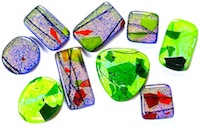Fire Polishing Fused Glass

Fire polishing is used to round and polish the edges of a piece of fusing glass that has been "cold worked" by grinding, drilling or sawing.
The fused glass piece is heated and held at the selected temperature until the edges are nicely rounded with a shiny finish.
The following is atutorial on polishing small pieces of COE 90 fused dichroic glass.
Bullseye glass was used as the base for the different dichroic styles.
After fusing the glass was cut with a glass cutter and then ground on a grinder to achieve the final shape.

When ground the pieces are left in a water filled container to ensure that the fine grit from the grinding process does not dry out.
If the glass is not kept wet it is very difficult to remove the grit which will leave dark lines when heated in the kiln.
Clean with a nail brush and soapy water and then dry carefully.
Upon completion the glass is placed on shelf paper on a kiln shelf and then loaded into a glass fusing kiln.
The temp is gradually lifted to around 1000 F with the kiln lid slightly open. After the shelf paper binders are burnt off the lid is closed and the temperature taken to between 1300 and 1400 degrees and held for about twenty minutes.
The pieces are checked during this time and if the edges have become nicely rounded the kiln is switched off and allowed to cool to room temperature
After polishing the glass should be nicely rounded and polished, ready to be finished as fused dichroic glass pendants
Polishing works best on flat items. Glass that has been slumped in a mold may be difficult to polish due to the closeness of the fusing and slumping temperatures.
This temperature closeness can result in the slumped item losing its shape. By carefully watching the process and polishing at a lower temperature it is sometimes possible to achieve a result.
Return From Fire Polishing Glass To The Glassworks
Return To Home Page



